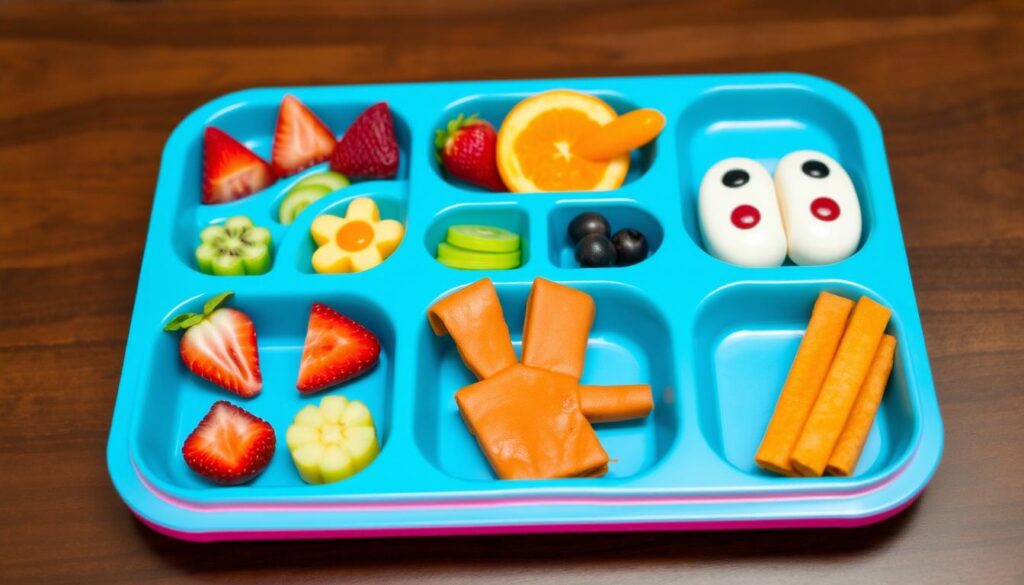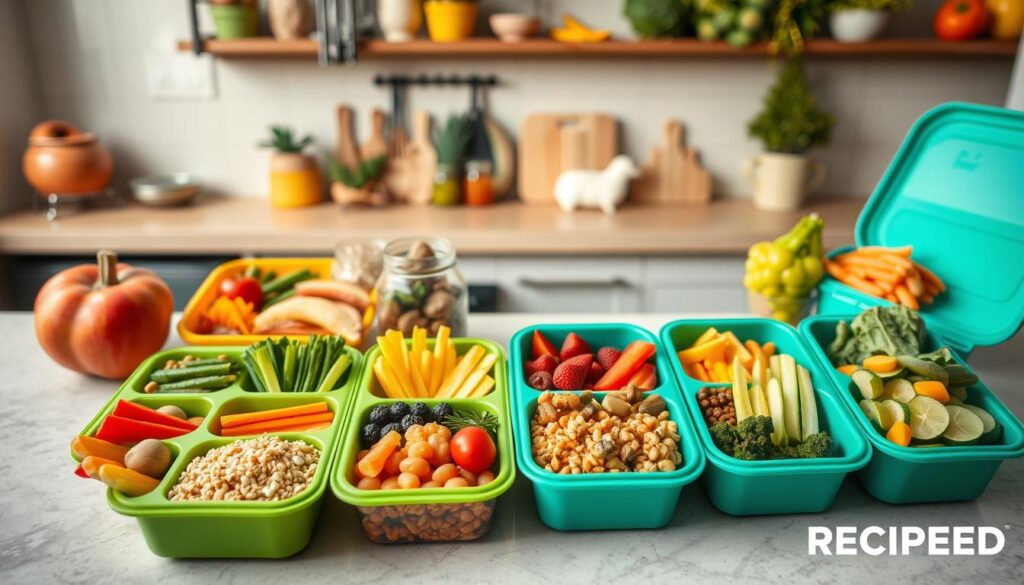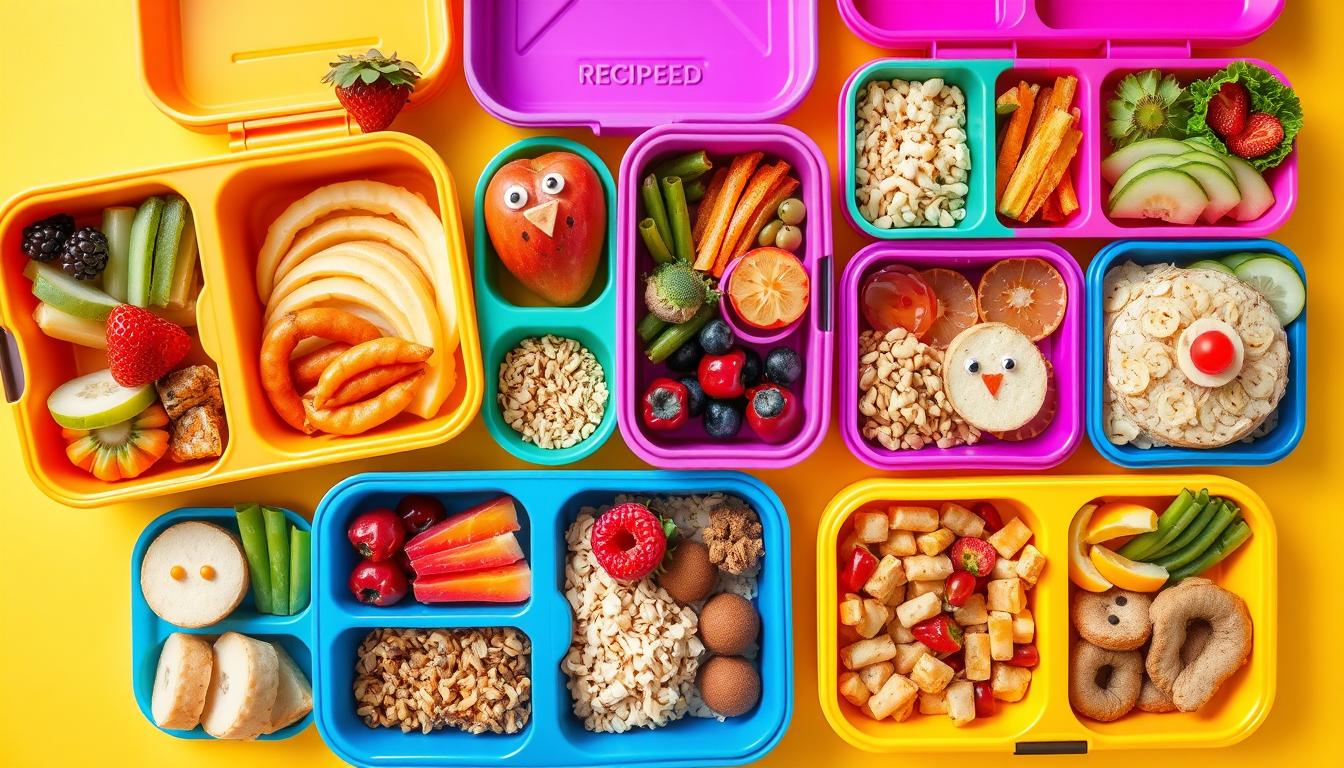Packing healthy lunches for kids is a fun challenge for parents. It’s important to make meals that are both nutritious and appealing. This ensures your preschooler gets the nutrients they need to grow.
Preschool lunches are more than just sandwiches. They’re about making meals that are balanced and colorful. These meals should excite your child’s imagination and provide the nutrients they need.
Every parent wants their child to have a nutritious lunch at school. The right foods can give kids energy and help them learn. Plus, it helps them develop healthy eating habits for life.
We’ve picked lunch ideas that are varied, nutritious, and tasty. These meals are quick to make, easy to pack, and meet the dietary needs of kids. Get ready to change how you pack lunches for your preschooler!
Table of Contents
Importance of Nutrition in Preschool Lunches
Nutrition is key for your child’s growth and development. Making healthy lunches is more than just feeding them. It’s about giving them the foundation for their future health and learning.
Healthy meals for preschoolers are essential. They fuel growing bodies and minds. Research shows some shocking facts about kids’ nutrition:
- Only 16% of packed lunches at preschools include a vegetable
- Nearly 2 out of 3 adolescents do not eat whole fruit daily
- More than 160 million children worldwide are living with obesity
Benefits of Balanced Meals
Balanced nutrition is vital for your child’s development. The Kid’s Healthy Eating Plate suggests a smart way to plan meals:
- Half the plate with colorful fruits or vegetables
- One-quarter with whole grains
- Remaining quarter with healthy proteins
“Food is the foundation of children’s health and potential.” – Pediatric Nutrition Expert
How Nutrition Affects Development
Good nutrition affects everything from brain function to physical growth. Kids who eat balanced meals do better in:
- Cognitive performance
- Immune system strength
- Energy levels
- Emotional regulation
The American Heart Association says kids should have less than 25 grams of added sugar a day. By choosing nutrient-rich, whole foods, you help your child develop healthy eating habits for life.
Fun and Creative Lunch Ideas
Turning mealtime into an adventure can change everything for preschoolers. Bento box lunches make meals fun and colorful. They spark kids’ imagination and make eating exciting.
Kids enjoy meals that are interactive and look good. Kid-friendly finger foods make lunch fun and healthy. Let’s look at some ideas that will make your kids look forward to lunch!
Colorful Vegetable Wraps
Make vegetable wraps that are both fun and healthy:
- Use soft tortillas as a canvas
- Spread cream cheese or hummus as a base
- Add colorful vegetable strips
- Roll tightly and slice into pinwheel shapes
“Eating with your eyes first” is especially true for children!
Fruit and Yogurt Parfaits
Layered parfaits are both tasty and pretty:
- Greek yogurt provides protein
- Fresh fruit adds natural sweetness
- Granola creates a crunchy texture
| Ingredient | Nutritional Benefit |
|---|---|
| Greek Yogurt | High in protein, supports growth |
| Berries | Rich in antioxidants, vitamins |
| Granola | Provides fiber, energy |
Bento box lunches are a fun way to eat healthy. They let kids explore different foods. By using kid-friendly finger foods, you’ll make mealtime exciting and nutritious.
Easy-to-Make Recipes for Busy Parents
Preparing lunch for your preschooler doesn’t have to be stressful. With smart hacks and easy recipes, you can make tasty, healthy meals. These will make your child look forward to lunchtime.
Busy parents need quick, simple meals that are still nutritious. The goal is to save time while making lunches fun and healthy.
No-Cook Sandwiches That Kids Love
Make mornings easier with these simple sandwich ideas:
- Turkey and cheese roll-ups
- Sunbutter and banana sandwich
- Cream cheese and cucumber pinwheels
“Simplicity is the ultimate sophistication in lunch preparation” – Adapted from Leonardo da Vinci
Snackable Lunch Boxes for Easy Eating
Make fun, nutritious lunch box combos that are easy to make and fun for kids:
- Cheese cubes
- Cherry tomatoes
- Whole grain crackers
- Sliced fruits
These recipes can be made ahead of time, saving you morning hours. Pro tip: Involve your children in lunch prep to make it a fun family activity!
Using airtight containers and prepping ingredients in bulk can change your meal prep. A well-planned lunch is a happy lunch!
Incorporating Whole Grains
Whole grains are full of nutrients for preschoolers, making meals healthier. They help your child grow strong and healthy.
Whole Grain Options Kids Will Love
Making healthy lunches for kids is easy. Here are some tasty whole grain choices they’ll love:
- Whole wheat bread for sandwiches
- Brown rice salads
- Quinoa-based pasta dishes
- Whole grain crackers
- Oatmeal muffins
Nutritional Benefits of Whole Grains
Whole grains are great for kids’ health. They have lots of nutrients that help them grow well.
| Nutrient | Benefit for Preschoolers |
|---|---|
| Fiber | Supports digestive health |
| Protein | Helps muscle development |
| B Vitamins | Boosts energy levels |
| Minerals | Strengthens immune system |
“Whole grains are nature’s multivitamin for growing children” – Pediatric Nutrition Expert
Adding whole grains to your child’s diet is key. Just half of their grain intake can make a big difference in their nutrition.
Protein-Packed Preschool Lunch Ideas
Protein is key for your child’s growth. Making healthy lunches that kids love is a fun challenge. Easy recipes with protein keep your preschooler full and happy all day.
Preschoolers need protein to grow fast. The right protein sources are vital for their nutrition.
Kid-Friendly Dip with Veggies
Make lunches fun with protein-rich dips that make veggies exciting. Here are some tasty choices:
- Hummus with carrot and cucumber sticks
- Greek yogurt-based ranch dip
- Bean dip with colorful bell pepper strips
These dips add protein and make veggies fun for kids who are picky.
Mini Turkey and Cheese Roll-Ups
Roll-ups are a great way to add protein to lunches. Try these protein-packed options:
- Turkey and cheese roll-ups
- Chicken and avocado wraps
- Hard-boiled egg with whole grain crackers
| Protein Source | Protein Amount |
|---|---|
| ½ cup milk | 4 grams |
| ¼ cup beans | 4-5 grams |
| ½ egg | 4 grams |
| 1 oz meat | 8 grams |
Pro tip: Mix up protein sources to keep lunches fun and balanced.
“Variety is key to maintaining your child’s interest in healthy meals.” – Nutrition Experts
By using different protein sources, you’ll make lunches that are both healthy and fun for your preschooler.
Incorporating Fruits and Vegetables
Getting kids to like fruits and veggies can be tough. September is Fruit and Veg Month. It’s a great time to make healthy lunches fun and colorful.

It’s important to make food fun for kids. Studies say kids might need to try a new food up to 15 times before they like it. How you present food can really help them want to try new things.
Fun Ways to Serve Vegetables
Here are some ways to make veggies exciting in lunches:
- Create vegetable “flowers” using cookie cutters
- Design faces on plates using different colored vegetables
- Pair veggies with tasty, kid-approved dips
- Include hidden vegetables in muffins or pasta salads
Creative Fruit Arrangements
Here are some fun ways to include fruit in lunches:
- Craft fruit kebabs with colorful combinations
- Create fruit “sushi” rolls using thin fruit slices
- Use cookie cutters to shape fruits into fun designs
- Prepare fruit and nut energy bites for quick snacks
“Eating fruits and vegetables can be an adventure, not a chore!” – Pediatric Nutrition Expert
A Bento box is great for organizing and showing off these colorful, healthy lunches. Making fruits and veggies fun to look at and easy to eat can help your child enjoy a balanced meal.
Managing Food Allergies and Preferences
It can be tough for parents to manage food allergies and dietary needs when packing preschool lunches. About 8% of American kids have food allergies. It’s important to make meals that are safe and include everyone.
Knowing about food allergies helps parents pick better lunch options. The most common allergies in kids are:
- Peanuts (3.2%)
- Tree nuts (2.1%)
- Eggs (1.8%)
- Milk (1.2%)
Allergen-Free Ideas
Here are some ideas for nut-free lunches:
- Try sunflower seed butter instead of peanut butter
- Use dairy-free milk like almond or oat milk
- Choose gluten-free bread or wraps
“Safety and nutrition go hand in hand when preparing meals for children with allergies.” – Pediatric Nutrition Association
Tips for Picky Eaters
For vegetarian lunches that picky eaters might like, try these tips:
- Let kids help plan meals
- Make dishes colorful and fun to look at
- Introduce new foods slowly with foods they already like
- Offer protein-rich vegetarian options like hummus or bean salads
Talking to preschool staff about allergies and special diets is key. Being creative and proactive helps make sure your child has safe, tasty, and healthy lunches.
Preparing Lunches Ahead of Time
Streamlining your preschooler’s lunch prep can change your life. Easy recipes and smart hacks make mornings calm and peaceful.

Preparing meals ahead has many benefits. It saves time and reduces stress. Plus, your child gets to enjoy tasty, healthy lunches.
Strategic Meal Prep Tips for Parents
Good lunch prep starts with planning. Here are some hacks to make your life easier:
- Batch cook proteins like chicken or hard-boiled eggs on weekends
- Invest in quality storage containers with multiple compartments
- Prep ingredients in advance for quick assembly
- Freeze sandwiches and muffins for grab-and-go options
Creatively Using Leftovers
Turn dinner leftovers into fun lunches. Grilled chicken makes great wraps, and roasted veggies are perfect for salads. Pasta can be turned into cold meals.
“Meal prep isn’t about perfection, it’s about making healthy eating easier for your family.”
When using leftovers, keep these tips in mind:
- Store components separately to maintain freshness
- Use airtight containers to prevent sogginess
- Keep wet and dry ingredients apart
- Label containers with dates
By following these tips, you’ll have stress-free mornings. Your preschooler will love the exciting, healthy lunches you prepare.
Keeping Food Fresh and Safe
Packing healthy lunches for kids is all about food safety and keeping things fresh. Parents pack over 250 meals a year for daycare kids. This makes it key to keep food quality and child health in mind.
Safe lunch prep is more than just picking the right ingredients. It’s about controlling temperatures and storing food right. This helps avoid foodborne illnesses and keeps meals nutritious.
Best Practices for Packing Lunches
- Use insulated lunch bags with cold packs
- Choose leak-proof containers
- Pack hot foods in thermal containers
- Separate wet and dry ingredients
Safe Storage Tips for Childcare
When making lunch hacks for daycare, keep these tips in mind:
- Label all containers with child’s name
- Include date of preparation
- Maintain proper temperature zones
- Clean lunch containers regularly
“Fresh food is safe food – prioritize your child’s nutritional journey”
Healthy lunches for kids need careful planning. Try to mix proteins, carbs, and fruits. Always keep food safety top of mind. This way, your child gets nutritious, safe meals all day.
Encouraging Healthy Eating Habits
Teaching preschoolers about nutrition makes mealtime fun. When kids help prepare healthy lunches, they learn about food’s importance. Simple tasks like sorting veggies or measuring ingredients make learning fun.
Kid-friendly finger foods are great for introducing new nutrients. Encourage kids to try different tastes and textures. Making fruit kebabs or DIY Lunchables together makes meal prep a fun learning experience.
Teaching Kids About Nutrition
Explaining food groups in simple ways helps preschoolers understand the importance of balanced meals. Show them how colors like green, red, and yellow represent different nutrients. Use visual aids and hands-on activities to make learning exciting.
Involving Kids in Lunch Preparation
Letting kids help with lunch builds their confidence and teaches them important skills. Teach them about choosing ingredients, kitchen safety, and making balanced meals. This approach makes healthy eating fun and empowers kids to make good food choices.
